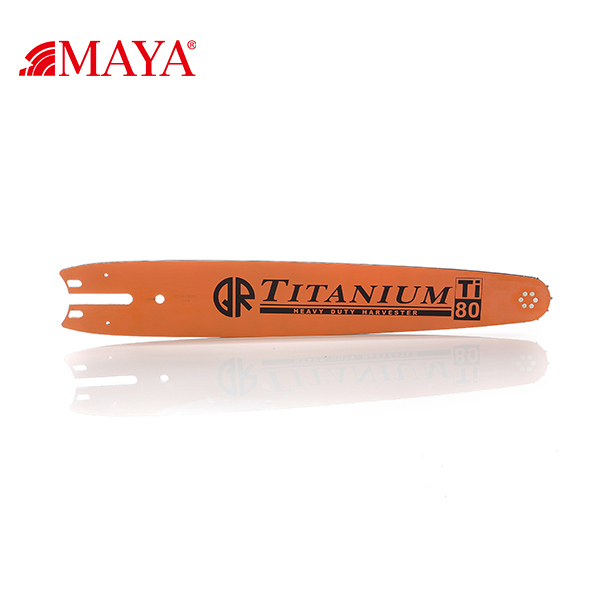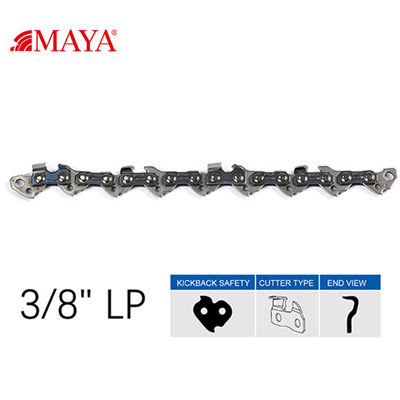Contact Us


News content

In the realm of chainsaw operation, longevity and performance are paramount. Regular maintenance of essential components such as guide bars and saw chains not only ensures smooth operation but also extends the lifespan of your equipment. In this comprehensive guide, we'll delve into the importance of maintenance intervals for guide bars and saw chains, exploring key practices to prolong their working life and optimize chainsaw performance.
Guide bars and saw chains undergo significant wear and tear during operation, necessitating regular maintenance to uphold cutting efficiency and safety. Maintenance intervals vary depending on factors such as frequency of use, cutting conditions, and environmental factors. Establishing a routine maintenance schedule is essential for preserving the integrity and functionality of these critical chainsaw components.
Guide bars serve as the foundation for the saw chain, providing stability and guidance during cutting operations. To ensure optimal performance and longevity, adhere to the following maintenance practices:
1. Regular Inspection: Conduct visual inspections of the guide bar for signs of wear, damage, or warping. Look for indications of bar groove wear, such as unevenness or burrs, which can affect chain movement and cutting precision.
2. Cleaning: Remove debris, sawdust, and resin buildup from the guide bar surface and groove using a wire brush or specialized cleaning tool. Ensure thorough cleaning to prevent accumulation that can impede chain movement and cause overheating.
3. Lubrication: Apply a thin layer of high-quality bar and chain oil to the guide bar's groove to reduce friction and facilitate smooth chain movement. Proper lubrication helps prevent premature wear and prolongs the lifespan of the guide bar and saw chain.
4. Tension Adjustment: Check and adjust the tension of the saw chain regularly to maintain optimal performance and prevent premature wear on the guide bar and chain. Ensure proper tensioning according to the manufacturer's specifications.
5. Rotation: Periodically rotate the guide bar to promote even wear along its length, extending its overall lifespan and ensuring consistent cutting performance. Rotate the guide bar every time you replace or sharpen the saw chain to distribute wear evenly.

Saw chains are the cutting edge of the chainsaw, responsible for slicing through wood with precision and efficiency. To keep your saw chain in optimal condition, follow these maintenance practices:
1. Sharpening: Regularly sharpen the saw chain teeth using a file or chainsaw sharpener to maintain cutting efficiency and precision. Dull chain teeth can increase cutting time, strain on the chainsaw motor, and the risk of kickback.
2. Depth Gauges: Check and adjust the depth gauges (rakers) to the manufacturer's specifications to ensure proper chain cutting depth and minimize kickback risk. Properly adjusted depth gauges help maintain cutting efficiency and safety.
3. Cleaning: Clean the saw chain thoroughly after each use to remove sawdust, resin, and debris that can accumulate during operation. Soak the chain in a solution of warm water and detergent, then rinse and dry it thoroughly before reinstallation.
4. Lubrication: Apply lubricating oil to the saw chain's drive links to reduce friction and heat generation during operation. Proper lubrication helps prevent premature wear and extends chain lifespan, ensuring smooth and efficient cutting performance.
5. Chain Replacement: Monitor the condition of the saw chain and replace it promptly if signs of excessive wear, damage, or stretching are observed. A worn-out chain can compromise cutting efficiency and pose safety risks to the operator.
Determining the optimal maintenance intervals for guide bars and saw chains requires consideration of several factors, including:
• Frequency of Use: Chainsaws used intensively or for prolonged periods may require more frequent maintenance than occasional-use chainsaws.
• Cutting Conditions: Cutting hardwoods, frozen wood, or abrasive materials can accelerate wear on guide bars and saw chains, necessitating shorter maintenance intervals.
• Environmental Factors: Operating in dusty or humid environments can contribute to accelerated wear and corrosion, requiring more frequent cleaning and lubrication.
In conclusion, maintaining guide bars and saw chains at regular intervals is crucial for maximizing cutting efficiency, prolonging working life, and ensuring safe operation of chainsaws. By adhering to a structured maintenance regimen and monitoring the condition of these critical components, chainsaw operators can optimize performance, minimize downtime, and extend the lifespan of their equipment. Prioritize proact
More
Discover how to enhance your chainsaw's cutting efficiency by selecting the right guide bar and saw chain. Learn about different types, maintenance tips, and key factors for optimizing performance.
Discover the differences between solid and laminated guide bars for chainsaws. Explore the pros and cons of each type and learn how to choose the right option for your cutting needs.
Looking for the perfect tool for your gardening needs? Explore our selection of mini saw chains, designed for light duty work and home gardening tasks. With options powered by electricity, batteries, or gasoline, you'll find the ideal solution for your outdoor maintenance projects.
Discover comprehensive steps for inspecting and maintaining guide bars and saw chains to enhance chainsaw longevity and performance. Learn essential practices for wear detection, damage prevention, and replacement to ensure optimal cutting efficiency.
More
Email: qirui@qiruibar.com
Tel:0086-571-82308666
Add: No. 390, Xiangdafang Industrial Park, Wenyan Street, Xiaoshan District,Hangzhou,Zhejiang,China
Website: www.qiruibar.com



Contact Us
Contact Us
